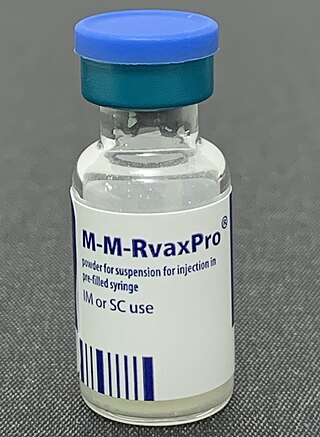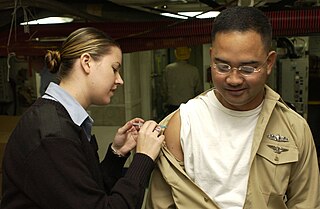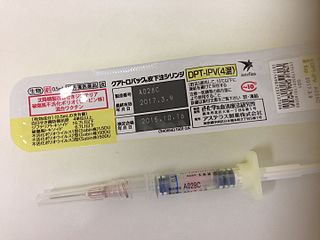Related Research Articles

The MMR vaccine is a vaccine against measles, mumps, and rubella, abbreviated as MMR. The first dose is generally given to children around 9 months to 15 months of age, with a second dose at 15 months to 6 years of age, with at least four weeks between the doses. After two doses, 97% of people are protected against measles, 88% against mumps, and at least 97% against rubella. The vaccine is also recommended for those who do not have evidence of immunity, those with well-controlled HIV/AIDS, and within 72 hours of exposure to measles among those who are incompletely immunized. It is given by injection.

Varicella zoster virus (VZV), also known as human herpesvirus 3 or Human alphaherpesvirus 3 (taxonomically), is one of nine known herpes viruses that can infect humans. It causes chickenpox (varicella) commonly affecting children and young adults, and shingles in adults but rarely in children. VZV infections are species-specific to humans. The virus can survive in external environments for a few hours.

The DPT vaccine or DTP vaccine is a class of combination vaccines against three infectious diseases in humans: diphtheria, pertussis, and tetanus. The vaccine components include diphtheria and tetanus toxoids and either killed whole cells of the bacterium that causes pertussis or pertussis antigens. The term toxoid refers to vaccines which use an inactivated toxin produced by the pathogen which they are targeted against to generate an immune response. In this way, the toxoid vaccine generates an immune response which is targeted against the toxin which is produced by the pathogen and causes disease, rather than a vaccine which is targeted against the pathogen itself. The whole cells or antigens will be depicted as either "DTwP" or "DTaP", where the lower-case "w" indicates whole-cell inactivated pertussis and the lower-case "a" stands for "acellular". In comparison to alternative vaccine types, such as live attenuated vaccines, the DTP vaccine does not contain the pathogen itself, but rather uses inactivated toxoid to generate an immune response; therefore, there is not a risk of use in populations that are immune compromised since there is not any known risk of causing the disease itself. As a result, the DTP vaccine is considered a safe vaccine to use in anyone and it generates a much more targeted immune response specific for the pathogen of interest. However, booster doses are recommended every ten years to maintain immune protection against these pathogens.

Influenza vaccines, also known as flu shots, are vaccines that protect against infection by influenza viruses. New versions of the vaccines are developed twice a year, as the influenza virus rapidly changes. While their effectiveness varies from year to year, most provide modest to high protection against influenza. The United States Centers for Disease Control and Prevention (CDC) estimates that vaccination against influenza reduces sickness, medical visits, hospitalizations, and deaths. Immunized workers who do catch the flu return to work half a day sooner on average. Vaccine effectiveness in those over 65 years old remains uncertain due to a lack of high-quality research.

Meningococcal disease describes infections caused by the bacterium Neisseria meningitidis. It has a high mortality rate if untreated but is vaccine-preventable. While best known as a cause of meningitis, it can also result in sepsis, which is an even more damaging and dangerous condition. Meningitis and meningococcemia are major causes of illness, death, and disability in both developed and under-developed countries.
The MMRV vaccine combines the attenuated virus MMR vaccine with the addition of the chickenpox vaccine or varicella vaccine. The MMRV vaccine is typically given to children between one and two years of age.

Pneumococcal conjugate vaccine is a pneumococcal vaccine and a conjugate vaccine used to protect infants, young children, and adults against disease caused by the bacterium Streptococcus pneumoniae (pneumococcus). It contains purified capsular polysaccharide of pneumococcal serotypes conjugated to a carrier protein to improve antibody response compared to the pneumococcal polysaccharide vaccine. The World Health Organization (WHO) recommends the use of the conjugate vaccine in routine immunizations given to children.

Gardasil is an HPV vaccine for use in the prevention of certain strains of human papillomavirus (HPV). It was developed by Merck & Co. High-risk human papilloma virus (hr-HPV) genital infection is the most common sexually transmitted infection among women. The HPV strains that Gardasil protects against are sexually transmitted, specifically HPV types 6, 11, 16 and 18. HPV types 16 and 18 cause an estimated 70% of cervical cancers, and are responsible for most HPV-induced anal, vulvar, vaginal, and penile cancer cases. HPV types 6 and 11 cause an estimated 90% of genital warts cases. HPV type 16 is responsible for almost 90% of HPV-positive oropharyngeal cancers, and the prevalence is higher in males than females. Though Gardasil does not treat existing infection, vaccination is still recommended for HPV-positive individuals, as it may protect against one or more different strains of the disease.

A zoster vaccine is a vaccine that reduces the incidence of herpes zoster (shingles), a disease caused by reactivation of the varicella zoster virus, which is also responsible for chickenpox. Shingles provokes a painful rash with blisters, and can be followed by chronic pain, as well as other complications. Older people are more often affected, as are people with weakened immune systems (immunosuppression). Both shingles and postherpetic neuralgia can be prevented by vaccination.

Hepatitis B vaccine is a vaccine that prevents hepatitis B. The first dose is recommended within 24 hours of birth with either two or three more doses given after that. This includes those with poor immune function such as from HIV/AIDS and those born premature. It is also recommended that health-care workers be vaccinated. In healthy people, routine immunization results in more than 95% of people being protected.
NmVac4-A/C/Y/W-135 is the commercial name of the polysaccharide vaccine against the bacterium that causes meningococcal meningitis. The product, by JN-International Medical Corporation, is designed and formulated to be used in developing countries for protecting populations during meningitis disease epidemics.
Meningococcal vaccine refers to any vaccine used to prevent infection by Neisseria meningitidis. Different versions are effective against some or all of the following types of meningococcus: A, B, C, W-135, and Y. The vaccines are between 85 and 100% effective for at least two years. They result in a decrease in meningitis and sepsis among populations where they are widely used. They are given either by injection into a muscle or just under the skin.

Measles vaccine protects against becoming infected with measles. Nearly all of those who do not develop immunity after a single dose develop it after a second dose. When rate of vaccination within a population is greater than 92%, outbreaks of measles typically no longer occur; however, they may occur again if the rate of vaccination decrease. The vaccine's effectiveness lasts many years. It is unclear if it becomes less effective over time. The vaccine may also protect against measles if given within a couple of days after exposure to measles.

The Vaccines for Children Program (VFC) is a federally funded program in the United States providing no-cost vaccines to children who lack health insurance or who otherwise cannot afford the cost of the vaccination. The VFC program was created by the Omnibus Budget Reconciliation Act of 1993 and is required to be a new entitlement of each state's Medicaid plan under section 1928 of the Social Security Act. The program was officially implemented in October 1994 and serves eligible children in all U.S. states, as well as the Commonwealth of Puerto Rico, the U.S. Virgin Islands, American Samoa, Guam, and the Commonwealth of the Northern Mariana Islands.

Tetanus vaccine, also known as tetanus toxoid (TT), is a toxoid vaccine used to prevent tetanus. During childhood, five doses are recommended, with a sixth given during adolescence.
National Immunization Technical Advisory Group (NITAG) is an advisory committee consisting of multidisciplinary groups of experts responsible for providing information to national governments that is used to make evidence-based decisions regarding vaccine and immunization policy. The majority of industrialized and some developing countries have formally established advisory committees to guide immunization policies; other countries are working towards establishment of such committees.
DTaP-IPV-HepB vaccine is a combination vaccine whose generic name is diphtheria and tetanus toxoids and acellular pertussis adsorbed, hepatitis B (recombinant) and inactivated polio vaccine or DTaP-IPV-Hep B. It protects against the infectious diseases diphtheria, tetanus, pertussis, poliomyelitis, and hepatitis B.

A hexavalent vaccine, or 6-in-1 vaccine, is a combination vaccine with six individual vaccines conjugated into one, intended to protect people from multiple diseases. The term usually refers to the children's vaccine that protects against diphtheria, tetanus, pertussis, poliomyelitis, haemophilus B, and hepatitis B, which is used in more than 90 countries around the world including in Europe, Canada, Australia, and New Zealand.

Nancy Messonnier is an American physician who served as the director of the National Center for Immunization and Respiratory Diseases at the Centers for Disease Control and Prevention from 2016 to 2021. She worked on the CDC's response to the COVID-19 pandemic in the United States.
The Strategic Advisory Group of Experts (SAGE) is the principal advisory group to World Health Organization (WHO) for vaccines and immunization. Established in 1999 through the merging of two previous committees, notably the Scientific Advisory Group of Experts and the Global Advisory Group by Director-General of the WHO Gro Harlem Brundtland. It is charged with advising WHO on overall global policies and strategies, ranging from vaccines and biotechnology, research and development, to delivery of immunization and its linkages with other health interventions. SAGE is concerned not just with childhood vaccines and immunization, but all vaccine-preventable diseases. SAGE provide global recommendations on immunization policy and such recommendations will be further translated by advisory committee at the country level.
References
- ↑ Smith, Jean Clare; Hinman, Alan R; Pickering, Larry K. (2014-10-24). "History and Evolution of the Advisory Committee on Immunization Practices — United States, 1964–2014". Morbidity and Mortality Weekly Report (MMWR). 63 (42): 955–8. PMC 5779473 . PMID 25340913.
- ↑ Smith, Jean Clare (2010). "The structure, role, and procedures of the U.S. Advisory Committee on Immunization Practices (ACIP)". Vaccine. 28: A68–A75. doi: 10.1016/j.vaccine.2010.02.037 . PMID 20413002.
- ↑ Norris, Michelle (2011-07-20). "Rising Costs Complicate Vaccine Guidelines". NPR . Retrieved 2011-08-20.
- 1 2 "ACIP charter". National Center for Immunization and Respiratory Diseases. 2014-04-01. Retrieved 2015-11-20.
- ↑ "ACIP Agendas, Minutes, Videos, Presentations | Immunization Practices | CDC". www.cdc.gov. Retrieved 2015-11-19.
- ↑ "New Framework (GRADE) for Development of Evidence-Based Recommendations by the Advisory Committee on Immunization Practices". www.cdc.gov. Retrieved 2015-11-19.
- ↑ Kempe, A.; Allison, M. A.; MacNeil, J. R.; O'Leary, S. T.; Crane, L. A.; Beaty, B. L.; Hurley, L. P.; Brtnikova, M.; Lindley, M. C.; Liang, J. L.; Albert, A. P.; Smith, J. C. (2018). "Knowledge and Attitudes Regarding Category B ACIP Recommendations Among Primary Care Providers for Children". Academic Pediatrics. 18 (7): 763–768. doi:10.1016/j.acap.2018.04.005. PMC 6123258 . PMID 29678594.
- ↑ "The ACIP-VFC vaccine resolutions". National Center for Immunization and Respiratory Diseases. 2015-06-30. Retrieved 2015-11-20.
- ↑ "ACIP | Home | Advisory Committee on Immunization Practices | CDC". www.cdc.gov. Retrieved 2015-11-19.
- ↑ "ACIP members". National Center for Immunization and Respiratory Diseases. 2015-09-30. Retrieved 2015-11-20.
- ↑ "ACIP Agendas, Minutes, Videos, Presentations | Immunization Practices | CDC". www.cdc.gov. Retrieved 2015-11-19.
- ↑ "National Academies release framework for equitable allocation of a COVID-19 vaccine for adoption by HHS, state, tribal, local, and territorial authorities". ScienceDaily. 2020-10-02. Retrieved 2021-01-01.
- ↑ Oliver, Sara E. (2020). "The Advisory Committee on Immunization Practices' Interim Recommendation for Use of Pfizer-BioNTech COVID-19 Vaccine — United States, December 2020". MMWR. Morbidity and Mortality Weekly Report. 69 (50): 1922–1924. doi: 10.15585/mmwr.mm6950e2 . ISSN 0149-2195. PMC 7745957 . PMID 33332292.
- ↑ Piper, Kelsey (2020-12-22). "Who should get the vaccine first? The debate over a CDC panel's guidelines, explained". Vox. Retrieved 2021-11-15.